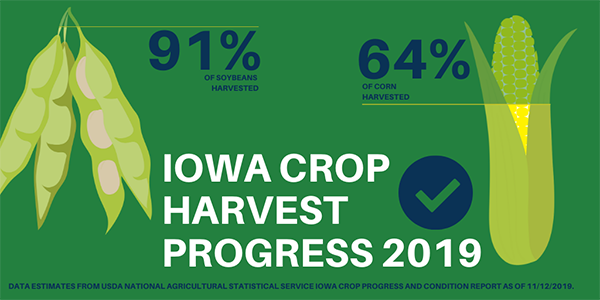Iowa Crop Progress and Conditions Report
Nov. 4 – 10, 2019
DES MOINES, Iowa (Nov. 12, 2019) – Iowa Secretary of Agriculture Mike Naig today commented on the Iowa Crop Progress and Conditions report released by the USDA National Agricultural Statistics Service. The report is released weekly from April through November.
“It’s feeling more like winter than fall. Parts of the state reported the lowest overnight temperatures on Nov. 12 since 1986,” said Secretary Naig. “Temperatures are expected to warm up closer to normal by the end of the week, which will help melt some snowpack and allow farmers to resume harvesting.”
The weekly report is also available on the USDA’s website at nass.usda.gov.
Crop Report
Statewide there were 5.0 days suitable for fieldwork during the week ending November 10, 2019 although winter weather moved across Iowa bringing more snowfall to the northern half of the State according to the USDA, National Agricultural Statistics Service. There were reports across the State concerning propane shortages slowing corn harvest due to the high moisture content of the crop and the need to dry it down.
Topsoil moisture condition was rated 0 percent very short, 2 percent short, 81 percent adequate and 17 percent surplus. Subsoil moisture condition was rated 0 percent very short, 2 percent short, 80 percent adequate and 18 percent surplus.
Sixty-four percent of the corn crop has been harvested for grain, 9 days behind last year and 10 days behind the 5-year average. Producers in the Northwest, North Central and Southeast Districts have harvested over 70 percent of their expected crop, while the Northeast District fell further behind with just 47 percent complete. Moisture content of field corn being harvested for grain was at 20 percent.
Ninety-one percent of the soybean crop has been harvested, one week behind average. The South Central District remained the furthest behind at 71 percent complete, but closed the gap as producers in the district harvested nearly one-quarter of their expected crop during the week ending November 10, 2019.
Cattle continued to battle below normal temperatures. There were also reports of cattle grazing in corn fields and some feeding of hay in the State.
Weather Summary
Provided by Justin Glisan, Ph.D., State Climatologist, Iowa Department of Agriculture and Land Stewardship
Cold conditions continued to grip Iowa during the first full week of November. Average temperatures were coldest across northern Iowa, where departures of 10 to 12 degrees below normal were reported. Iowa’s average temperature was 32.0 degrees, 7.4 degrees below normal. Unseasonably dry conditions were also observed over a majority of Iowa with departures generally between 0.20 to 0.60 inches. Above average snowfall was also observed across northern Iowa.
A center of low pressure moved through Iowa during Sunday (3rd) afternoon and evening, bringing light rainfall across the state’s northern half. General totals varied from 0.01 inches to 0.03 inches from Des Moines (Polk County) to Waterloo (Black Hawk County) with the highest accumulations across north-central Iowa; Britt (Hancock County) reported 0.30 inches while Elma (Howard County) observed 0.36 inches. With cloudy and rainy conditions across much of the state, daytime highs remained in the mid 40s north to low 50s south.
A fast-moving cold front moved across Iowa on Monday (4th) shifting winds to a northwesterly direction with high temperatures reaching into the mid to upper 40s. Cloudy conditions persisted into Tuesday (5th) as overnight lows dipped into the 20s. High pressure moved into the region during the day and was quickly followed by low pressure systems that brought snowfall along the Iowa-Minnesota border through early Wednesday (6th) morning. As the system was exiting eastern Iowa, another round of light snow moved through much of the state’s northern three-quarters. Three to four inches fell across northern Iowa with locally heavier amounts near Decorah (Winneshiek County), where six inches was observed; snow totals tapered off to a dusting towards southern Iowa.
Overnight temperatures into Thursday (7th) plummeted into the single digits across northern Iowa with lows across southern Iowa remaining in the mid to upper teens. The average nighttime temperature was 12 degrees, 20 degrees below average. A dome of high pressure took control across the Midwest during the day with gradually clearing conditions after sunset. Daytime highs were well below normal, from the mid 20s north to low 30s south. As the high pressure slowly propagated east, winds shifted out of the south, helping highs on Friday (8th) rebound into the upper 30s and low 40s under mostly sunny skies.
Saturday (9th) was the warmest day of the month so far as a warm front lifted north across Iowa. Daytime highs in southwestern Iowa reached into the low 60s with mid to upper 50s across much of the rest of the state; mid 40s were reported in northeastern Iowa as cold northwesterly flow around a low pressure in Wisconsin held temperatures below average. The statewide average high was 54 degrees, four degrees warmer than normal. Cloud cover moved back into northern Iowa through Sunday morning (10th) with a northerly wind and lows in the mid to upper 30s, slightly colder than average.
Weekly precipitation totals ranged from no accumulation at multiple stations in southern Iowa to 0.76 inches in St. Ansgar (Mitchell County). The statewide weekly average precipitation was 0.11 inches, while the normal is 0.52 inches. The average snowfall across Iowa was 0.70 inches. The week’s high temperature of 65 degrees was reported on the 9th at Little Sioux (Harrison County), 15 degrees above normal. The week’s low temperature of -3 degrees was reported on the 8th at Cresco (Howard County), 30 degrees below normal. Soil temperatures as of Sunday were generally in mid 30s north to low 40s south.
